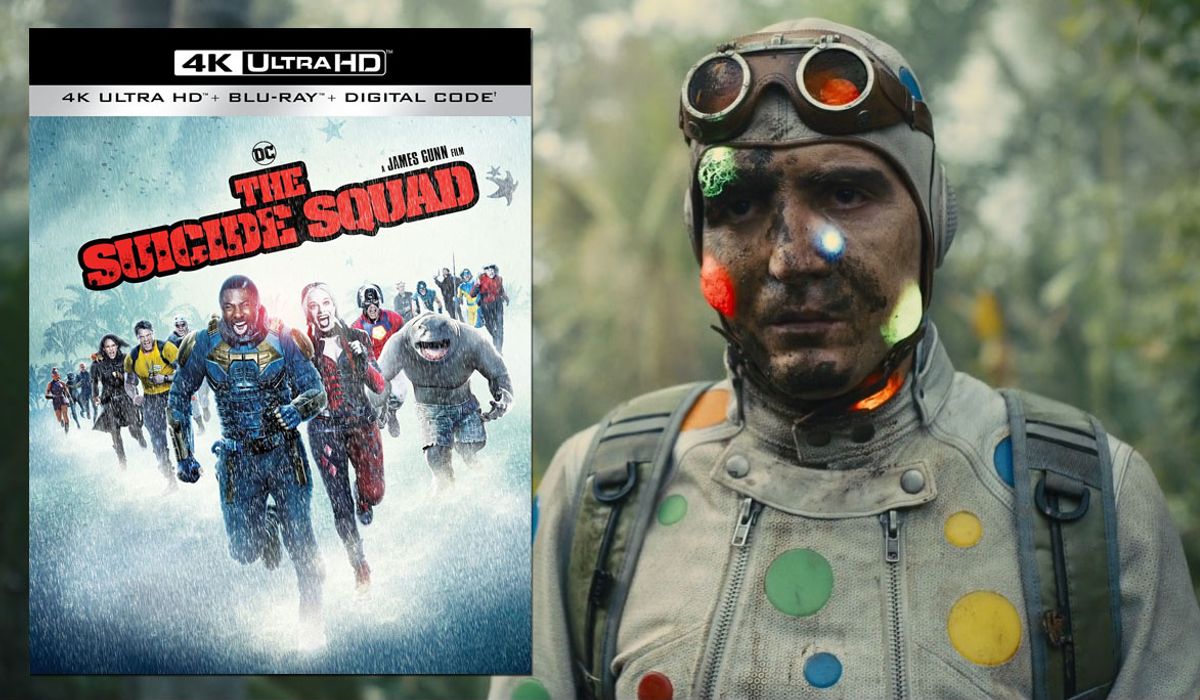
DC Comic’s team of nasty villains returned to the theaters and debuted on HBO Max this summer in a rousing stand-alone sequel that now explodes on an ultra-high definition disc in The Suicide Squad (Warner Bros. Home Entertainment, rated R, 1.90:1 aspect ratio, 132 minutes, $49.98)
Director James Gunn, who aptly delivered a pair of blockbusters in the Marvel Cinematic Universe with his dynamic homage to the Guardians of the Galaxy, takes his first stroll into the other comics’ universe and does not disappoint.
His formula, delivered once again, mixes the perfect blend of humor and high-octane action, and now also adds jaw-dropping violence (thanks to the “R” rating). The result is one ridiculously entertaining movie that more than makes up for its 2016 uneven, mediocre predecessor.
As relayed in many a comic book series and that forgettable last movie, leader of black ops Task Force X (aka Suicide Squad) Amanda Waller (Viola Davis) temporarily releases a selection of highly dangerous inmates from Belle Reve prison on deadly missions with the promise of reduced sentences.
In this case, the eventual team of Bloodsport (Idris Elba), Peacemaker (John Cena), King Shark (voiced by Sylvester Stallone), Cleo Cazo aka Ratcatcher 2 (Daniela Melchio), Polka Dot Man (David Dastmalchian), Harley Quinn (Margot Robbie), with help from hero Col. Rick Flag (Joel Kinnaman), is tasked with stopping the dictators of the South American island Corto Maltese and the legendary Thinker (Peter Capaldi) from unleashing a mind-controlling entity on the world.
The team creates chaos at every turn allowing for not only big and noisy action sequences, reference the battle with Starro and an escape by Harley Quinn, but also a steady stream of gory kills.
Older comic book fans will really love the tragic main “entity” protagonist, the extraterrestrial Starro the Conqueror originally seen in The Brave and the Bold, No. 28 (an especially notable cover for the Silver age resurgence of comics) and distinguished as the first appearance of the Justice League of America in a comic book series starting way back in 1960.
Mr. Gunn also embraces the vast, decades-long history of DC Comics to bring other infamous villains to the screen, though often treating them like disposable wipes.
Take the case of the first action scene where an unlucky Suicide Squad team runs into deadly trouble. The team included Captain Boomerang (first appearance The Flash, No. 117, December 1960); Javelin (Green Lantern, No. 173, February 1984); Savant (Birds of Prey, No. 56, August 2003); Mongal (Showcase ‘95, No. 8, September 1995); and The Detachable Kid (based on the hero Arms-Fall-Off-Boy from Secret Origins, No. 46, December 1989).
The famed director was even allowed to take liberties with the DC canon to update and emotionally refine some of the more absurd characters.
Take the case of Polka Dot Man aka Abner Krill, first seen in Detective Comics, No. 300 back in 1962.
He is not simply some two-bit criminal in Gotham City with an electronic suit that created polka dots that transformed into devices, he is now a tragic figure infected with an interdimensional virus that has polka dots eating away at his body that he must expel every day and twinned with a personality enhanced by serious mommy issues.
To reiterate, Mr. Gunn‘s latest foray into pulpy pop culture strikes gold with movie fans due to not only his passion for action cinema but also his appreciation of the film’s odd sequential art source material.
4K in action: Viewers get a gritty 2160p screen-filling presentation culled from a 4K digital intermediate delivering reference-quality clarity and, when cinematographer Henry Braham chooses, eye-popping hues.
Examples of this dynamic duo of crispness and color abound and include watching a yellow finch pecking at pieces of a bloodied brain out of a skull of a body floating in the ocean as the glowing sun rises; Polka Dot Man vomiting a colorful bunch of neon-lit polka dots in the jungle; and a too-detailed shot of a piece of tile piercing the human heart while still in the body as it’s pumping out blood.
The highlight of the 2160p captures Harley Quinn during her escape in which an animated backdrop of colorful flowers and birdies (in a Disney-esque style) follows her as she uses a pair of assault weapons and Javelin’s staff to wipe out a battalion of enemy soldiers.
Best extras: First and by far the most enjoyable, found on both 4K and Blu-ray disc, is an optional commentary track with the director who happens to also be the sole writer of the movie.
Mr. Gunn starts by reminding viewers that he should take notes but always forgets so his comments are all off-the-cuff. He says he always meticulously storyboards every shot of his films, although often inspiration occurs on the set.
He offers a fairly continuous stream of thoughts covering opinions on the cast’ the film’s inspiration (specifically, war capers such as “The Dirty Dozen” and “Kelly’s Heroes”); the importance of the camera equipment used to capture keeping characters in motion; wanting a “Saving Private Ryan” opening to the film; and scenes he had problems with.
Minutia touched on includes mentioning the characters in the upcoming Peacemaker television series, the complexity of Bloodsport’s costume, Mr. Cena’s fear of heights and how rats make fantastic pets.
His words are backed up by eight production featurettes (roughly 50-minutes long) on the Blu-ray that cover bringing King Shark and Starro to life; cast and crew gushing about the director; and scene breakdowns including the intense Harley Quinn escape.
Most notable of the bunch, but much too short, is an almost 12-minute featurette that offers the comic book origins of this Suicide Squad as told by the director and more importantly, the principal writer of the sequential art John Ostrander.
Viewers also get three trailers styled in different genres, a gag reel and deleted scenes.








